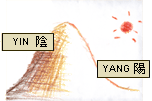Ancient Chinese people were greatly interested in the relationships
and patterns that occurred in nature. Instead of studying isolated
things, they viewed the world as a harmonious and holistic entity.
In their eyes, no single being or form could exist unless it was seen
in relation to its surrounding environment. By simplifying these relationships,
they tried to explain complicated phenomena in the universe.
 |
Modern symbol of Yin Yang
陰陽符號 |
|
What is the Yin Yang Theory?
Yin yang theory is a kind of logic, which views things in relation
to its whole. The theory is based on two basic components: yin
and yang, which are neither materials nor energy. They combine
in a complementary manner and form a method for explaining relationships
between objects. Gradually, this logic was developed into a
system of thought that was applied to other areas. Traditional
Chinese Medicine (TCM) is an example of one area where the yin
yang theory is used to understand complicated relationships
in the body. |

 |
Early Daoism representation of Yin Yang
陰陽之卦象形成的表達 |
|
The
Origin of the Yin Yang Theory
The original concept of yin and yang came from the observation
of nature and the environment. "Yin" originally referred to
the shady side of a slope while "yang" referred to the sunny
side. Later, this thinking was used in understanding other things,
which occurred in pairs and had complementary and opposing characteristics
in nature. Some examples include: sky and earth, day and night,
water and fire, active and passive, male and female and so on.
Working with these ideas, ancient people recognized nearly all
things could have yin and yang properties. Yin and yang can
describe two relative aspects of the same phenomena such as
the example of the slope, or they can describe two different
objects like sky and earth. |
| |
|
 |
Usually, yang is associated with functional aspect of an object and has more energetic qualities, for example, moving, ascending, expanding, heat, bright, progressing, active and hyper-functioning states. Yin, on the other hand, is associated with the physical form of an object and has less energetic qualities such as stillness, descending, contracting, cold, dark, degenerating, latent and under-functioning states. |

| |
| Frame of References |
Yang |
Yin |
| Light |
Bright |
Dark |
| Temperature |
Hot |
Cold |
| Position |
Upper |
Lower |
| Action |
Movement |
Rest |
| Direction |
Outward |
Inward |
| Physiological functions |
Excitatory |
Inhibitory |
|
|